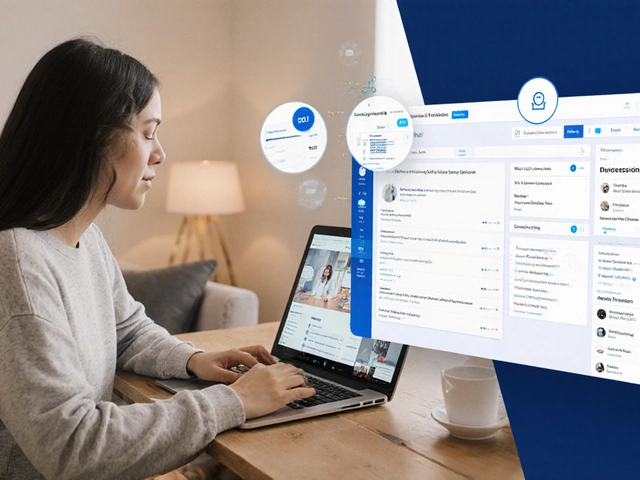In our digital age, eLearning has emerged as a beacon for those seeking knowledge beyond the traditional classroom setting. Whether you're a student aiming to expand your horizons, or a professional craving new skills, online education platforms present a wealth of opportunities. The realm of eLearning is diverse, but at its heart are three main types, each designed to cater to different learning preferences and needs.
Understanding these categories not only enriches our appreciation for digital learning but also guides educators and learners alike in making informed decisions that enhance educational experiences. As we embark on this exploration, consider how each type might fit into your own learning path.
- Introduction to eLearning
- Synchronous eLearning
- Asynchronous eLearning
- Blended Learning
- Advantages and Challenges
- Choosing the Right Type
Introduction to eLearning
The world of eLearning is vast and captivating, offering an array of opportunities that break the boundaries of traditional education. With its roots tracing back to the invention of the internet, eLearning has steadily evolved, transforming how we approach learning and development. The concept is not merely about remote education; it's about creating an engaging, interactive, and accessible environment for learners of all ages. Online platforms remove geographical barriers, enabling students and professionals worldwide to access quality education from the comfort of their homes or workplaces.
eLearning's appeal lies in its flexibility and convenience. Unlike conventional classrooms, eLearning allows learners to progress through materials at their own pace, accommodating various learning styles and schedules. This personalization is a major reason for its growing popularity, especially in corporate training environments where time is precious. As the demand for online education grows, platforms are leveraging innovative technologies like AI and VR to enhance the learning experience, making it more immersive and tailored to individual needs.
The statistics speak volumes about the impact of eLearning. According to a report by Global Market Insights, the eLearning market size surpassed USD 315 billion in 2021 and is expected to grow at a CAGR of over 20% from 2022 to 2028. This surge is driven by the increasing necessity for upskilling and reskilling in today's rapidly changing job market. Companies are recognizing the need to equip their workforce with the latest knowledge and skills to remain competitive, and eLearning platforms provide an effective solution offering various digital learning tools seamlessly.
Interestingly, the rise of eLearning has also democratized education. It offers a level playing field, providing resources and opportunities to those who might otherwise be excluded due to socio-economic or geographic limitations. This democratization is vital for empowering individuals and communities, ultimately contributing to a more informed and skilled global society. By removing traditional constraints, eLearning nurtures an environment where knowledge is readily available to anyone with the curiosity and drive to learn.
"The beautiful thing about learning is that no one can take it away from you." – B.B. King
Moreover, the adaptability of eLearning platforms means they can be tailored to specific needs, whether teaching primary school students or providing advanced training for medical professionals. This versatility ensures that learners can always find content that is relevant, up-to-date, and applicable to their goals. The blend of technology with education isn't just about transferring knowledge; it's about enhancing it, making learning an engaging and dynamic experience.
As we delve deeper into the types of eLearning, it becomes clear that this isn't just an alternative to traditional education—it's a powerful complement. The landscape is rich with promise and potential, inviting educators and learners alike to explore innovative ways to convey knowledge and foster the love of learning in a myriad of settings. With each advancement, eLearning platforms are increasingly designed to cater to the diverse needs of today's learners, promising a bright future for digital education.
Synchronous eLearning
Synchronous eLearning is a groundbreaking approach that enables learners to engage in educational activities in real-time. This method effectively bridges geographical distances, providing a classroom-like environment through digital means. Imagine attending a class where you can interact with your instructor and peers just like you would in a traditional setting, only through your screen. With the growing reliance on technology in education, synchronous eLearning has become one of the significant capabilities of modern eLearning platforms. Tools such as live webinars, video conferencing, and interactive whiteboards facilitate direct interaction, ensuring that the learning experience remains immersive and dynamic. This method's real-time nature means learners can ask questions and receive immediate feedback, enhancing understanding and engagement.
One of the major elements of synchronous online education is its flexibility, combined with a sense of community. While you participate in live sessions, you are still afforded the convenience of not having to commute or adhere to a rigid schedule constantly. This is especially beneficial for businesses and organizations that seek to provide online education and upskilling opportunities to their employees without disrupting daily operations. According to a report by the eLearning Industry, nearly 84% of organizations operating remotely have integrated some form of synchronous learning in their training programs.
"The future of learning is not void of interaction; it is merely reimagined with fresh digital tools," comments Dr. Leonard Ashcroft, an innovator in educational technology.
The effectiveness of synchronous eLearning lies in its crafted environment where learners can converge and share knowledge. However, it is not without its challenges. A stable internet connection and access to digital devices are prerequisites. Additionally, the required alignment with different time zones can sometimes pose a hurdle. Educators also shoulder the responsibility of maintaining engagement throughout the sessions, as distractions are more prevalent in a home setting. Despite these drawbacks, the high level of interaction found in synchronous learning helps maintain motivation and accountability among learners—key components in any successful learning experience.
Tools and Technologies
The heart of synchronous learning resides in the technologies that support it. Platforms like Zoom, Microsoft Teams, and Google Meet have been adapted to create comprehensive eLearning environments. These tools offer features like breakout rooms, screen sharing, and real-time polls which enrich the learning experience. Another critical tool includes learning management systems (LMS) like Blackboard or Moodle, which seamlessly integrate synchronous sessions with educational resources and assessments. Through these tools, the realm of learning has expanded beyond geographical borders, fostering inclusive educational opportunities for all.
To benefit fully from the advantages of synchronous eLearning, it is crucial for both educators and learners to actively participate in creating an engaging atmosphere. Integrating multimedia elements such as videos, interactive quizzes, and discussions plays an essential role in the process. Instructors are encouraged to design lessons that leverage these technologies to foster collaboration and ensure students remain captivated throughout the course duration. With the increasing popularity and availability of digital learning tools, we are witnessing a significant shift in how online learning is perceived and integrated into everyday educational practices.

Asynchronous eLearning
In the bustling world of digital education, asynchronous eLearning stands as a popular choice for those who crave flexibility and autonomy in their learning routines. This type of eLearning platform allows students to access materials, lectures, and assignments at their own pace without the confines of a rigid schedule. It's an approach that acknowledges the diverse timetables and commitments of modern learners, making it especially appealing to working professionals and students scattered across various time zones. Asynchronous education relies heavily on pre-recorded videos, discussion boards, e-books, and interactive modules that students can engage with at their convenience. This method empowers learners to delve into subjects as deeply as they wish, offering the chance to pause, rewind, and review content as many times as necessary for thorough understanding.
One of the key advantages of asynchronous eLearning is the ability it offers to revisit complex topics. For instance, if a learner finds themselves puzzled over a particular concept, they can easily return to the relevant segment of a video or revisit discussion posts to gain clarity, a benefit not as readily available in traditional classroom settings or synchronous online sessions. Moreover, this type of online education fosters a self-directed learning style, encouraging students to become proactive in seeking knowledge and collaborating digitally with peers. It enables students to bring different perspectives to forum discussions, enriching the learning experience through diverse viewpoints from various cultural and professional backgrounds.
An interesting aspect of asynchronous learning is its potential to enhance both personal and professional development. Participants can often work on self-reflective exercises or engage in project-based tasks that promote critical thinking and problem-solving skills—valuable assets in today's fast-paced, ever-evolving job market. A 2023 report by the eLearning Industry platform reveals that over 60% of learners prefer the flexibility provided by asynchronous methods, citing ease of access and the ability to tailor their study schedules to personal priorities as primary reasons.
"Asynchronous learning calls for a shift from traditional teacher-driven instruction to a student-centered approach, where learners are empowered to take control of their educational journey," notes Dr. Joshua Davies, an expert in digital pedagogy.
This self-paced structure, while beneficial, does carry challenges. Time management becomes crucial as the absence of fixed-class times requires individuals to set their own deadlines and maintain momentum through discipline and motivation. To combat potential procrastination, many platforms now incorporate progress trackers, calendar notifications, and goal-setting features to keep learners on track. A good practice for succeeding in asynchronous eLearning environments involves creating a personalized study regimen that includes regular check-ins with progress and participation in discussion forums to stay engaged.
Blended Learning
Blended learning is an educational approach that thoughtfully combines the traditional face-to-face classroom experiences with the modern-day advantages of eLearning. This hybrid model aims to create a more personalized learning experience by integrating digital media in a structured classroom setting. It provides learners with the best of both worlds—direct interaction with instructors and peers, and the flexibility and accessibility of online education. The concept of blended learning isn't entirely new; it's an evolution brought forth by the digital age to address the limitations of both online learning and traditional classroom settings.
One of the reasons blended learning is gaining popularity is its ability to cater to different learning styles. For instance, while some students thrive in a classroom environment, engaging in discussions and receiving immediate feedback, others may benefit from the self-paced nature of online modules where they can review content at their own speed. An interesting fact about blended learning is its potential for improved retention rates. According to a study by the U.S. Department of Education, students in blended learning programs outperform those in traditional face-to-face instruction. This can be attributed to the richer variety of content delivery methods that cater to individual learning needs.
"Blended learning is not just adding technology to the classroom; it's a thoughtful approach to personalize and enrich the learner's experience," says Education Leader Dr. John Walker.
The success of blended learning heavily relies on its strategic implementation. Instructors must carefully design courses that seamlessly integrate in-person interactions with digital learning tools. This involves clear communication of course objectives, ensuring that online resources complement in-class teaching, and utilizing data-driven insights to refine learning strategies. Moreover, educators play a vital role in facilitating both components of blended learning—guiding online discussions, assessing digital activities, and providing constructive feedback on assignments. By doing so, they create an interactive and dynamic learning environment that bridges the gap between theory and practice.
Another significant advantage of blended learning is its capacity to cater to the logistical and geographical challenges faced by educational institutions. Schools and universities can optimize their resources by accommodating more students through virtual classes while reducing the need for physical infrastructure. For corporate training, blended learning allows organizations to reach a wider audience, offering uniform training programs across multiple locations. Coupled with analytics from online platforms, companies can track progress and measure the effectiveness of their training interventions.
To summarize, blended learning represents a transformative shift in the education landscape. As institutions and organizations continue to embrace this model, it becomes imperative to focus on creating a comprehensive learning experience where technology serves as an enabler rather than a distraction. With its unique blend of in-person and virtual experiences, blended learning not only addresses the diverse needs of learners but also prepares them for the challenges of a rapidly changing world driven by technological advancement.

Advantages and Challenges
eLearning, a pivotal component of the modern educational landscape, serves as both a boon and a perplexing puzzle for learners and instructors alike. The advantages of eLearning are compelling, offering a rich tapestry of opportunities that transcend geographical boundaries. One significant advantage is the unparalleled flexibility it offers, allowing learners to fit education into their busy lives without the constraints of a rigid timetable. This flexibility is particularly appealing for professionals looking to upskill while maintaining their current roles, as they can access courses at their own pace and convenience.
Another major benefit lies in the vast array of courses available, often spanning global subjects that might not be locally accessible. This encourages a culture of lifelong learning where students can continually expand their horizons and gain insights into diverse fields. In contrast to traditional classrooms, where the pace is determined by the entire group, online education allows for personalized learning environments where students can focus on areas that interest them or where they need additional practice. Resource availability, from video tutorials to interactive quizzes, further enriches the learning experience, making it more engaging and effective.
Scalability and Reach
The scalability of eLearning platforms is another standout advantage, reaching vast audiences across the globe without additional costs for physical infrastructure. This democratization of education means that someone in a remote village now has access to the same quality of education as someone in a major city, potentially leveling the playing field. Statistics show that over 60% of college students in the United States have taken at least one online course, underscoring the widespread acceptance and growth of digital learning platforms.
Despite these advantages, challenges persist. Not all learners thrive in the digital learning environment. Some may struggle with the initial self-discipline required to engage with remote courses effectively. Without the structured oversight provided in traditional classrooms, it's all too easy for less motivated students to fall behind. Technical issues can also pose significant barriers; access to a reliable internet connection and up-to-date devices is not universal, potentially excluding disadvantaged groups from these opportunities.
Human Interaction and Support
A common critique of eLearning is the perceived lack of human interaction, which is often seen as vital for a comprehensive learning experience. Face-to-face discussions and real-time feedback from instructors are harder to replicate online, potentially leading to feelings of isolation. To address this, many platforms now include forums and live Q&A sessions to foster community and engagement. As educational consultant Dr. Sandra Pollard notes,
"The key to effective eLearning lies in creating connections and maintaining a strong sense of community, much like traditional learning environments."
Balancing the technological and human aspects of learning requires careful planning and innovative solutions. While eLearning has carved out a significant niche within the educational sector, it is most effective when used in conjunction with traditional methods. By understanding and tackling these challenges, educators and learners can harness the full potential of eLearning platforms.
Choosing the Right Type
Selecting the most suitable eLearning platform for your needs can seem daunting given the myriad of options available. But fear not, understanding the nuances of each type can make the decision much easier. The primary goal is to align the type of eLearning with your learning objectives, time commitments, and personal preferences. If synchronous eLearning appeals to you, it's likely because you value real-time interaction and immediate feedback. This type of e-learning allows learners to engage in live discussions, participate in interactive sessions, and benefit from the immediate attention of educators and tutors. It's much like a virtual classroom, where the sense of community is palpable, making it ideal for learners who thrive in a structured environment.
On the other hand, if flexibility is high on your priority list, asynchronous eLearning could be the answer. This format permits you to learn at your own pace, at a time and place of your choosing. With resources like pre-recorded lectures, discussion forums, and downloadable materials, it presents a more personalized approach. This adaptability is a significant draw for those balancing learning with work or other commitments. Asynchronous eLearning not only caters to independent learners but also accommodates varied learning speeds, ensuring that no learner feels left behind.
Blended Learning strikes a balance between the two, offering a mix of online and face-to-face interactions. This hybrid model combines the best of both worlds, allowing for flexible learning schedules with the added personal touch of in-person sessions. Institutions and companies often favor blended learning for its comprehensive approach that supports diverse learning styles while maintaining a level of engagement often missing in traditional models.
"Blended learning creates opportunities for students to experience the best of both online education and traditional classroom learning," says Jane Hart, founder of the Center for Learning and Performance Technologies.
When choosing the right type, it's essential to consider not only the content delivery but also the technical infrastructure you have access to. Fast internet and access to digital devices are crucial for all types of eLearning. Additionally, evaluating your self-discipline and motivation can guide you whether a more structured schedule or a self-paced model will benefit your learning journey the most. Decision-making might also involve reviewing costs, as synchronous and blended models typically require more investment than their asynchronous counterparts. As you weigh these factors, remember that the flexibility and convenience offered by eLearning platforms open doors to endless learning possibilities.




